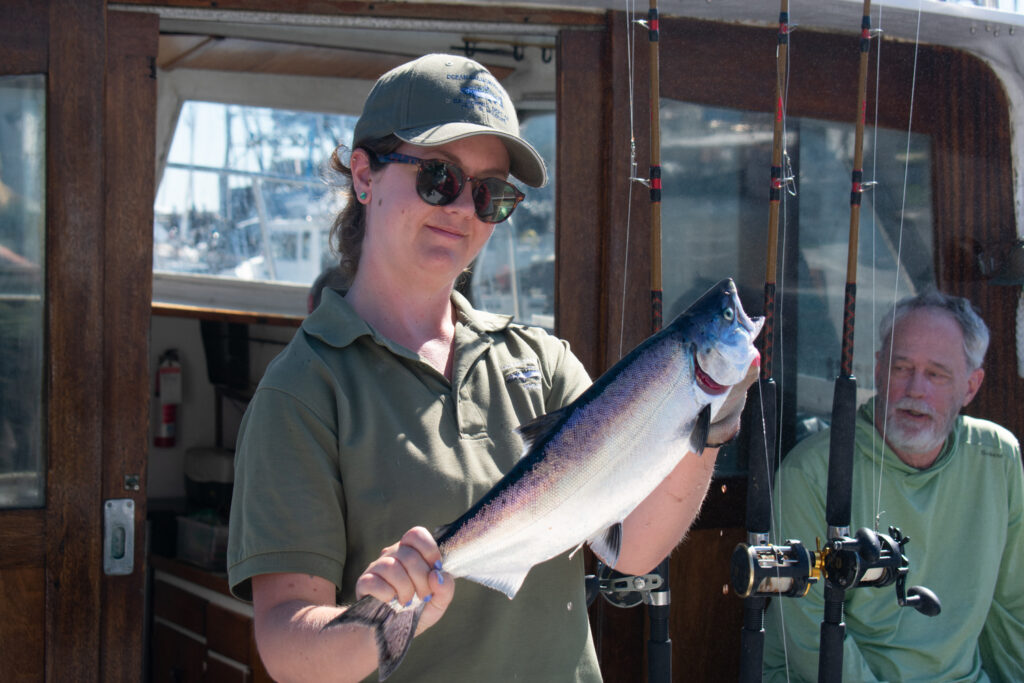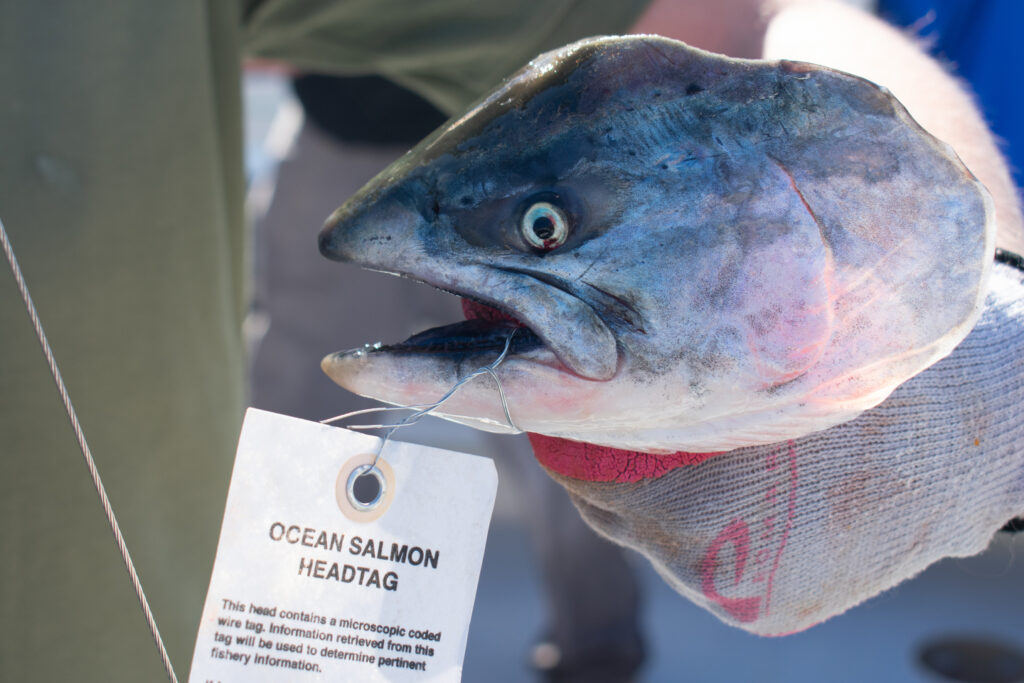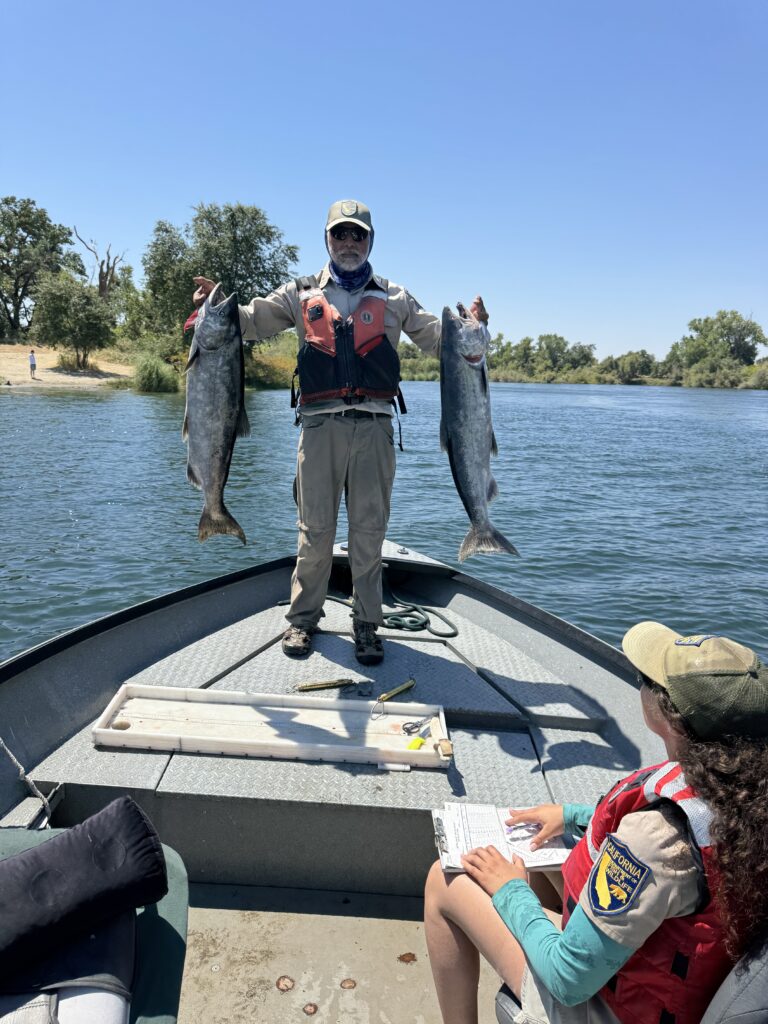California’s fall 2025 recreational ocean salmon fishery was a success, with 12,000 Chinook salmon taken by 12,400 anglers in four days of fishing. The weather conditions were excellent, which added to the high turnout. The fall harvest guideline of 7,500 Chinook salmon was reached between September 4 and 7. On September 17, National Marine Fisheries Service (NMFS) closed the remaining dates for the fishery that had been set to occur in September and October.
Anglers were allowed to fish between Pt. Reyes and Pt. Sur. The largest number of anglers caught fish in the San Francisco sub area. Catch rates out of Half Moon Bay were slow. Anglers had limited success in Monterey.

Emma Keller, Environmental Scientist for the Ocean Salmon Project – Marine Region of the California Department of Fish and Wildlife samples a Chinook salmon off of a charter vessel in September 2025. Image: California Department of Fish and Wildlife
“Now salmon are starting to migrate back to their native rivers. The salmon life cycle is ending for some fish,” said Emma Keller, Environmental Scientist for the Ocean Salmon Project – Marine Region of the California Department of Fish and Wildlife (CDFW).
CDFW said it is assessing the impact of the fishery. It is the agency’s first year having a limited season. The experience is teaching CDFW how to implement such a program.
Keller said there was “so much excitement” leading up to and during the fishery that sports fishing shops, charter fishing boats, and other small businesses saw an economic boost. CDFW workers are now processing Chinook salmon heads in the Santa Rosa lab, retrieving information on coded wire tags (CWTs) for hatchery fish.

A Chinook head taken to analyze the coded-wire tag in its snout. Such a tag contains stock-specific information about the fish, like its age, hatchery of origin, and release strategy. Image: California Department of Fish and Wildlife
Angela Forristall, Staff Officer – Salmon and Pacific Halibut for the Pacific Fishery Management Council (PFMC), said data analysis will help the PFMC determine whether the fishery stayed within the allowable exploitation rate and spawner escapement goals were met early next year.
“The harvest guideline is a management tool, whereas the management goals are making sure that allowable exploitation rates are not exceeded and spawner escapement goals are met,” said Forristall.
CDFW restricted the take area because it wanted to minimize negative impacts on the Klamath River fall Chinook and Central Valley Spring and Sacramento River Winter Chinook.
“For next season, we’re trying to maximize fishing opportunities while ensuring the health of those populations in particular,” said Keller.
The results from the fall 2025 ocean salmon recreational fishery will not impact in-river management measures. There are no changes to the in-river recreational salmon fishery section-specific season dates that the California Fish and Game Commission adopted in May 2025.
“Of note, section D on the Feather River and section A on the Mokelumne River closed on September 15. Therefore anglers are no longer permitted to fish for salmon in those sections,” said Colby Hause, Senior Environmental Scientist (Specialist) for CDFW.
Section D is the upper section of the Feather River that spans from the unimproved boat ramp above the Thermalito Afterbay Outfall to 200 yards above the Live Oak boat ramp. Section A of the Mokelumne River is the upper section that runs from Camanche Dam to Elliot Road.
CDFW will continue to monitor in-river populations, which is critical for developing pre-season abundance forecasts for managing 2026 commercial and recreational ocean salmon fisheries.

Two Chinook salmon caught on the Feather River, held up by Francisco Garcia, Technician for California Department of Fish and Wildlife. Image: California Department of Fish and Wildlife
